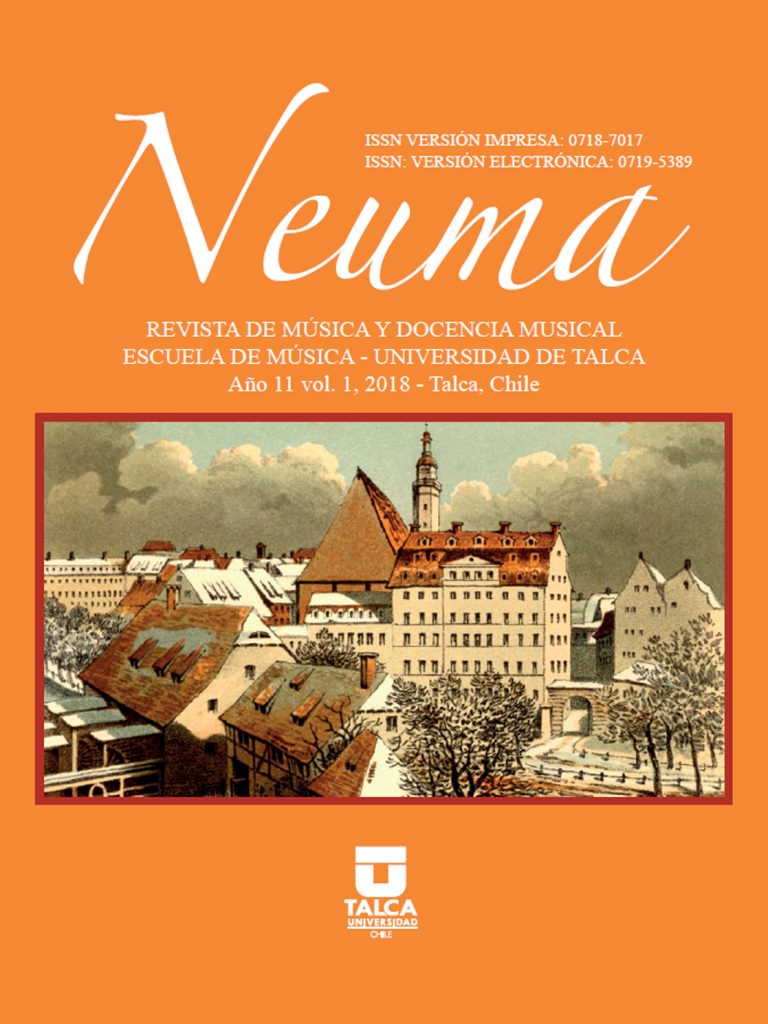Abstract
Musicology, in its historical perspective, commonly proposes the score as its primary referent. Influenced by formalist thinking, it’s in the musical score where form and inner coherence of the autonomous and self-sufficient musical work materialize. Based on assumptions from the field of performance studies, the article’s objective is to show how the human body and the physical conditions of the musical instrument itself reflect directly in musical writing. By ways of an historical analysis of guitar music notation from the Renaissance to the Twentieth Century, it is demonstrated how the score itself displays this dialogue between different dimensions which, in their totality, conform what we define as music.
References
Aguado, Dionisio (1825). Escuela de Guitarra. Madrid: Fuentenebro.
Amat, Joan Carles (1596). Guitarra española, y vandola. Gerona: Joseph Bró.
Beethoven, Ludwig van (1799). Sonata Patética N° 8, Op. 13. Viena: Eder.
Carulli, Ferdinando (1823). Fantasie Op. 204. Paris: Carli.
Cook, Nicholas (2013). Beyond the Score: Music as Performance. New York: Oxford University Press.
Corbetta, Francesco (1639). Scherzi armonici. Bolonia.
Dahlhaus, Carl (2003). Fundamentos de la historiografía de la música. Barcelona: Gedisa.
Díaz Soto, Roberto y Mario Alcaraz Ibora (2009). La guitarra: Historia, organología y repertorio. Alicante: Editorial Club Universitario.
Duarte, John (1976). La notazione della musica per chitarra. Il fronimo. Milan: Suvini Zerboni.
Fuenllana, Miguel de (1554). Orphénica Lyra. Sevilla: Martín de Montesdoca.
Grier, James (2008). La edición crítica de la música: Historia, método y práctica. Madrid: Akal.
Gilardino, Angelo (1975). Il problema della diteggiatura nelle musiche per chitarra. Il fronimo. Milan: Suvini Zerboni.
Giuliani, Mauro (1812). Sonata No.1 Op.15. Viena: Steiner & Co.
Giuliani, Mauro (1967). 120 arpeggi dall’Op.1. Ed. Ruggiero Chiesa. Milán: Subini Zerboni.
Goehr, Lydia (1992). The Imaginary Museum of Musical Works: An Essay in the Philosophy of Music. New York: Oxford University Press.
Hanslick, Eduard (1947/1854). De lo bello en la música. Buenos Aires: Ricordi.
Jeffery, Brian (1994). Fernando Sor, Composer and Guitarist. Londres: Tecla.
Kelly, Thomas Forest (2015). Capturing Music: The Story of Notation. New York: Norton.
Lawson, Colin (2011) ”La interpretación a través de la historia”. La interpretación musical. Jonathan Rink (coord.). Trad. Barbara Zitman. Madrid: Alianza.
Lecuona, Ernesto (2000). La Antigua. Arreglo de Barrueco, M. Los Angeles: Warner.
Lessing, Wolfgang (2014). “Versuch über Technik”. Verkörperungen der Musik. Interdisziplinäre Betrachtungen. Hiekel, Jörn Peter y Wolfgang Lessing (eds.). Bielefeld: Transcript, pp. 13-60.
Lhoyer, Antoine (1804). Sonata I Op. 17. Hamburgo: Jean Aug. Böhme.
Madrid, Alejandro L. (2009). “¿Por qué música y estudios de performance? ¿Por qué ahora?: una introducción al dossier”, Revista Transcultural de Música, 13, sin paginación. Consultado el 26 de mayo de 2018.
Mertz, Johann Kaspar (1857). Fantasie Hongroise Op. 65. Viena: Charles Haslinger.
Milán, Luis de (1536). El Maestro. Valencia: Francisco Díaz Romano.
Moretti, Federico (1825). La Promesa. Madrid: B. Wirmbs.
Pisador, Diego (1552). Libro de música de vihuela. Salamanca: Diego Pisador.
Shiner, Larry (2004). La invención del arte. Una historia cultural. Barcelona: Paidós.
Small, Christopher (1998). Musicking. The Meaning of Performing and Listening. Middletown, Connecticut: Wesleyan University Press.
Sor, Fernando (1814). Fantasie Op.7. París: Meissonier.
Spinacino, Francesco (1507). Intabulatura de lauto. Venecia: Ottaviano Petrucci.
Wade, Graham (2001). A Concise History of the Classic Guitar. Fenton, Montana: Mel Bay

This work is licensed under a Creative Commons Attribution-NonCommercial 4.0 International License.
Copyright (c) 2018 Neuma (Talca)


